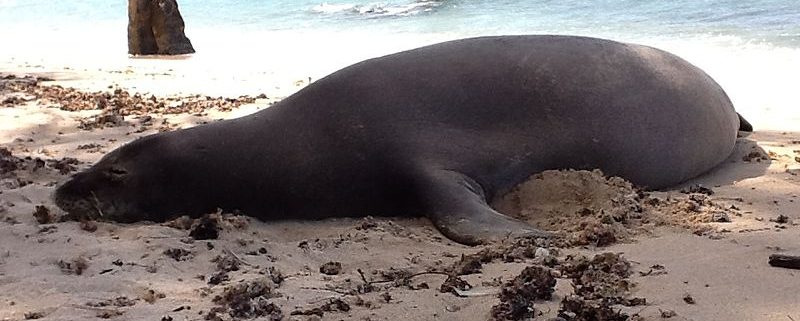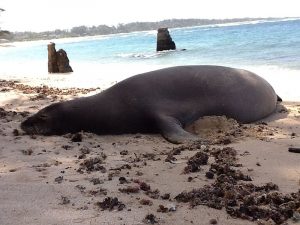Conservation of the Critically Endangered Hawaiian Monk Seals
by Laurel Zaima, RJD Intern
Education is always the first step towards the conservation and recovery of a species. The endangered species list intends to bring awareness and education to the public about species that are on the brink of extinction. There are several different classifications that explain the population status of species: least concern, near threatened, vulnerable, endangered, critically endangered, extinct in the wild, and extinct (Monachus Schauinslandi). One of the most primitive of all living phocid species, the Hawaiian Monk Seal, is categorized as critically endangered. In the mid-19th century, hunters targeted the Hawaiian Monk Seals for their precious skins and oils. The Monk Seal populations were hit so hard that they have yet to make a significant recovery. However, it is still possible for the Hawaiian Monk Seal populations to bounce back if the public is informed about the importance of conserving this species and the methods of successful conservation.
One of the reasons that hunters were capable of killing a significant amount of the Hawaiian Monk Seals in the 19th century was due to the seals’ behaviors and their small habitat range. The Hawaiian Monk Seals are an endemic species to the Hawaiian Islands, which means they are native to this chain of islands and they are found no where else on earth (Protected Resources Division). Their small range of habitat made them an easy target for hunters. Although Monk Seals can travel hundreds of miles into the open ocean, they are not migratory mammals and have a habit of frequenting the same beaches over and over (Protected Resources Division). They also are usually found sleeping on the Hawaiian Island Beaches or in underwater caves, sometimes for days at a time (Protected Resources Division).
The Monk Seal’s lackadaisical and predictable behaviors leave them extremely vulnerable to predation and hunters. Monk Seals do not live in colonies and are mostly solitary animals; however, when they occasionally lay in small groups on the beach together, they put themselves at higher risk against hunters. The anatomy of a Monk Seal also posses a hindrance towards their safety from predators on land. They are large mammals, ranging from 6-7 feet in length and weighing approximately 400-600 pounds, but they are equipped with short foreflippers. Therefore, they perform a modified “wiggle” when they try to move on land, which also leaves them highly susceptible to predation (Protected Resources Division). The Hawaiian Monk Seal’s behavior and habitat allowed the hunters in the mid-19th century to wipe out their population.
There is historical evidence of the sealing during the 19th century as being a major factor in the decline of the Hawaiian Monk Seal’s population. Honolulu served as an ideal trading stop for seal pelts because it is located in the middle of the Pacific Ocean (McClenachan, Loren). The most direct and compelling evidence of the irresponsible sealing practices during this time period comes from direct observations. It has been documented that a bystander saw “sealing boats [returning] to Honolulu with large numbers of seal pelts in the 1820s-1850s” (McClenachan, Loren). There was one specific boat, the Gambia, which was said to have killed 1,500 seals in the Northwest Hawaiian Islands in 1859 (McClenachan, Loren). The business that surrounded this massive sealing practice during this time period hurt the Monk Seals population almost to the point of extinction.
The Monk Seal’s population has not been able to make a full recovery due to a variety of threats that the species currently endures. Monk Seals that live in the Northwestern Hawaiian Islands have an average decline of 4%/year (Baker, Harting, Wurth, Johanos, 2). It has been found that the Hawaiian Monk Seal population was at 1,161 in 2008 and this number is steadily decreasing (Baker, Harting, Wurth, Johanos, 1). Monk Seals struggle with environmental factors such as a food deprivation in the Northwest Hawaiian Island region, disease outbreak, and loss of pupping beaches due to erosion (Protected Resources Division). The Hawaiian Monk Seals have been found with injuries or found dead “related to attacks by large sharks, mounting attempts by male Hawaiian Monk Seals, or entanglement in marine debris” (Johanos, Baker, 3). Due to their low numbers, the Hawaiian Monk Seals have a low genetic diversity, which can lead to inbreeding within populations (Johanos, Baker). Unfortunately, humans have a large effect on the restricted Monk Seal populations as well. Entanglement in marine debris, human interactions including by catch with fishing gear, mother pup disturbances, and intentional killing are some examples of human’s negative influence towards the Monk Seals (Protected Resources Division).

Fortunately, it is not too late to act now towards the conservation of the Hawaiian Monk Seals. There are steps that anyone can take to help bring their population numbers back up. (Picture 3; caption: A Hawaiian Monk Seal swimming in the Pacific off the coast of the Hawaiian Islands) The first step to be taken is to educate yourself and your peers about the threats towards the Hawaiian Monk Seals and the conservation efforts that can be taken. A great way to help with their population recovery is to “be a good neighbor to Hawaiian Monk Seals” by giving the seals space while they are on the beach or change locations completely, do not feed the seals, picking up marine debris, and use barbless circle hooks while fishing (Protected Resources Division). The public is also encouraged to participate in Monk Seal counting research to help assess the population of this endangered species, and to report all Monk Seal strandings to the National Marine Mammal Stranding and Entanglement Hotline. If these conservation methods are enacted and encouraged throughout the public, then there is a possibility that the Hawaiian Monk Seal can finally be removed from the critically endangered species list.
REFERENCES
Baker, Jason D., Albert L. Harting, Tracy A. Wurth, and Thea C. Johanos. Dramatic Shifts in Hawaiian Monk Seal Distribution Predicted from Divergent Regional Trends. Publication. N.p.: University of Nebraska, 2011. Print.
Johanos, Thea C., and Jason D. Baker. The Hawaiian Monk Seal in the Northwestern Hawaiian Islands, 2004. Publication. N.p.: National Oceanic and Atmospheric Administration, 2011. Print.
McClenachan, Loren. Historical Ecology of the Hawaiian Monk Seal: Summary of Historical Data Available to Estimate Historical Population Size. Publication. La Jolla: Scripps Institution of Oceanography, n.d. Print.
“Monachus Schauinslandi.” Red List. The IUCN, 2008. Web. 11 Nov. 2012. <http://www.iucnredlist.org/details/summary/13654/0>.
“Protected Resources Division.” NOAA. N.p., n.d. Web. 11 Nov. 2012. <http://www.fpir.noaa.gov/PRD/prd_hms_index.html>.
Wikimedia Commons. N.p., n.d. Web. 11 Nov. 2012. <http://commons.wikimedia.org/wiki/Main_Page>.





Leave a Reply
Want to join the discussion?Feel free to contribute!